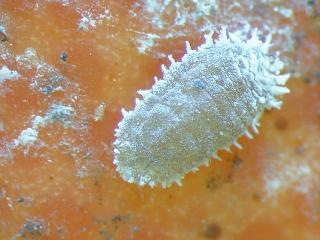Mealybugs
Mealybugs are about 3-7mm long and cause similar damage to aphids — distorted leaves, weakened plants covered with shiny honeydew, and sooty mould. Mealybugs are covered in a whitish ‘mealy’ wax, which helps retard the loss of water from their soft bodies. They generally prefer warm, humid, sheltered sites away from harsh environmental conditions and natural enemies.
Different species of mealybugs prefer different feeding sites. Some species feed in and under bark, some on the roots of pot plants while others feed on fruits, flowers or seed heads. The adults are slow-moving insects.
Mealybug populations can build up quickly. Similar to aphids, they feed by inserting their straw-like mouthparts into plant tissue. Feeding damage can be by direct removal of plant fluids and nutrients, and/or by the excretion of toxic salivary compounds into plant tissue.
Australia has several mealybugs which are worldwide pests, the worst being the long-tailed mealybug (Pseudococcus longispinus) which is present in Western Australia and the Citrophilous mealybug (Pseudococcus calceolariae), not yet identified in WA.
Most mealybugs have a number of often overlapping generations per year. Their development is dependent on temperature. Temperatures of about 25°C and a high relative humidity are optimum for mealybugs and, like aphids, their populations reach peaks in spring and autumn.
Eggs can be laid singly or in clusters, and female long-tailed mealybugs have been recorded laying as many as 200 eggs in a lifetime. Egg clusters are usually embedded in a cocoon of waxy filaments.
After hatching, the juveniles (crawlers) search for suitable feeding sites in sheltered areas. Crawlers can be dispersed by wind and progress through five moults before reaching adulthood. For males, the last juvenile stage pupates in a silk cocoon, and emerges as a winged adult. Adult males do not feed, having no mouthparts — their sole purpose is to mate with females.
Control
Because mealybugs have high reproductive capacities and multiple generations in a year, they have the potential to become resistant to pesticides very quickly. Fortunately mealybugs can be controlled using ‘soft’ methods including biological agents and low-toxicity pesticides, most of which are readily available to the home gardener.
Good control of mealybugs can be achieved by releasing parasitic wasps such as Leptomastix dactylopii and Anagyrus fusciventris into the infested area. The wasps lay their eggs into young mealybugs: on hatching, the wasp larvae feed on the internal fluids of the mealybugs. The mealybugs are usually killed when the wasp larvae pupate.
Predatory ladybird beetles also attack many species of mealybugs, including the long-tailed mealybug, although they don't match the effectiveness of the parasitic wasps in terms of control.
Predatory insects (and mites) are sold by a number of Australian companies. For your nearest supplier refer to the Australasian Biological Control Association.
Sprays with horticultural soap will desicate and suffocate the insects and horticultural oil will smother the insects but these organic products should not be used when the weather is above 32°C as plant leaves can burn. Alternative products are the low toxicity, residual chemicals imidacloprid and acetamiprid.

